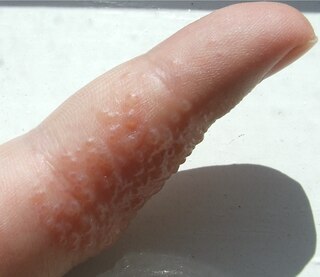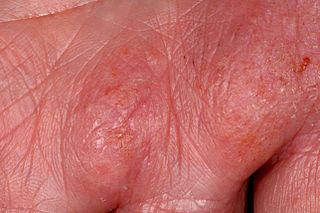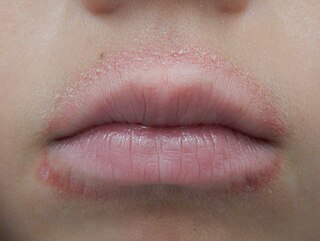
Methylchloroisothiazolinone, also referred to as MCI, is the organic compound with the formula S(C2HCl)C(O)N(CH3). It is a white solid that melts near room temperature. The compound is an isothiazolinone, a class of heterocycles used as biocides. These compounds have an active sulphur moiety that is able to oxidize thiol-containing residues, thereby effectively killing most aerobic and anaerobic bacteria. MCI is often used in combination with methylisothiazolinone, a mixture known as Kathon. The isothiazolinones have attracted attention because they can cause contact dermatitis. Methylchloroisothiazolinone is effective against gram-positive and gram-negative bacteria, yeast, and fungi.

Contact dermatitis is a type of acute or chronic inflammation of the skin caused by exposure to chemical or physical agents. Symptoms of contact dermatitis can include itchy or dry skin, a red rash, bumps, blisters, or swelling. These rashes are not contagious or life-threatening, but can be very uncomfortable.

Dyshidrosis is a type of dermatitis that is characterized by itchy blisters on the palms of the hands and bottoms of the feet. Blisters are generally one to two millimeters in size and heal over three weeks. However, they often recur. Redness is not usually present. Repeated attacks may result in fissures and skin thickening.

Bronopol is an organic compound that is used as an antimicrobial. It is a white solid although commercial samples appear yellow.

A patch test is a diagnostic method used to determine which specific substances cause allergic inflammation of a patient's skin.
Cocamidopropyl betaine (CAPB) is a mixture of closely related organic compounds derived from coconut oil and dimethylaminopropylamine. CAPB is available as a viscous pale yellow solution and it is used as a surfactant in personal care products and animal husbandry. The name reflects that the major part of the molecule, the lauric acid group, is derived from coconut oil. Cocamidopropyl betaine to a significant degree has replaced cocamide DEA.

Allergic contact dermatitis (ACD) is a form of contact dermatitis that is the manifestation of an allergic response caused by contact with a substance; the other type being irritant contact dermatitis (ICD).

Tetrazepam is a benzodiazepine derivative with anticonvulsant, anxiolytic, muscle relaxant and slightly hypnotic properties. It was formerly used mainly in Austria, France, Belgium, Germany and Spain to treat muscle spasm, anxiety disorders such as panic attacks, or more rarely to treat depression, premenstrual syndrome or agoraphobia. Tetrazepam has relatively little sedative effect at low doses while still producing useful muscle relaxation and anxiety relief. The Co-ordination Group for Mutual Recognition and Decentralised Procedures-Human endorsed the Pharmacovigilance Risk Assessment Committee (PRAC) recommendation to suspend the marketing authorisations of tetrazepam-containing medicines across the European Union (EU) in April 2013. The European Commission has confirmed the suspension of the marketing authorisations for Tetrazepam in Europe because of cutaneous toxicity, effective from the 1 August 2013.

Diazolidinyl urea is an antimicrobial preservative used in cosmetics. It is chemically related to imidazolidinyl urea which is used in the same way. Diazolidinyl urea acts as a formaldehyde releaser.

Isothiazolinone (sometimes isothiazolone) is an organic compound with the formula (CH)2SN(H)CO. A white solid, it is structurally related to isothiazole. Isothiazolone itself is of limited interest, but several of its derivatives are widely used preservatives and antimicrobials.

A formaldehyde releaser, formaldehyde donor or formaldehyde-releasing preservative is a chemical compound that slowly releases formaldehyde. Formaldehyde-releasers are added to prevent microbial growth and extend shelf life. The intent of these compounds is that they release formaldehyde at levels that suppress microbial growth but sufficiently low to not threaten humans. The use of these chemicals in cosmetics has elicited controversy.

DMDM hydantoin is an antimicrobial formaldehyde releaser preservative with the trade name Glydant. DMDM hydantoin is an organic compound belonging to a class of compounds known as hydantoins. It is used in the cosmetics industry and found in products like shampoos, hair conditioners, hair gels, and skin care products.
Eyelid dermatitis is commonly related to atopic dermatitis or allergic contact dermatitis. Volatile substances, tosylamide, epoxy hardeners, insect sprays, and lemon peel oil may be implicated, with many cases of eyelid contact dermatitis being caused by substances transferred by the hands to the eyelids.

Hand eczema presents on the palms and soles, and may sometimes be difficult or impossible to differentiate from atopic dermatitis, allergic contact dermatitis, and psoriasis, which also commonly involve the hands. Even a biopsy of all these conditions may not result in a definitive diagnosis, as all three conditions may demonstrate spongiosis and crusting on the hands.
Allergen of the Year is an annual award voted upon by the American Contact Dermatitis Society. This is "designed to draw attention to allergens that are very common, under-recognized, merit more attention because they are causing significant allergic contact dermatitis or are no longer causing significant relevant disease ".

Iodopropynyl Butyl Carbamate (IPBC) is a water-soluble preservative used globally in the paints & coatings, wood preservatives, personal care, and cosmetics industries. IPBC is a member of the carbamate family of biocides. IPBC was invented in the 1970s and has a long history of effective use as an antifungal technology.

Methyldibromo glutaronitrile (MDBGN) is a widely used preservative.

Nickel allergy is any of several allergic conditions provoked by exposure to the chemical element nickel. Nickel allergy often takes the form of nickel allergic contact dermatitis (Ni-ACD), a form of allergic contact dermatitis (ACD). Ni-ACD typically causes a rash that is red and itchy and that may be bumpy or scaly. The main treatment for it is avoiding contact with nickel-releasing metals, such as inexpensive jewelry. Another form of nickel allergy is a systemic form: systemic nickel allergy syndrome (SNAS) can mimic some of the symptoms of irritable bowel syndrome (IBS) and also has a dermatologic component.

Lip licker's dermatitis is a type of skin inflammation around the lips due to damage by saliva from repetitive lip licking and is classified as a subtype of irritant contact cheilitis. The resulting scaling, redness, chapping, and crusting makes a well-defined ring around the lips. The rash may extend as far as the tongue can reach and usually does not occur at the corners of the mouth. It commonly occurs during winter months but some people can have it year-round if lip licking is a chronic habit.

Metal allergies inflame the skin after it has been in contact with metal. They are a form of allergic contact dermatitis. They are becoming more common, as of 2021, except in areas with regulatory countermeasures.



















